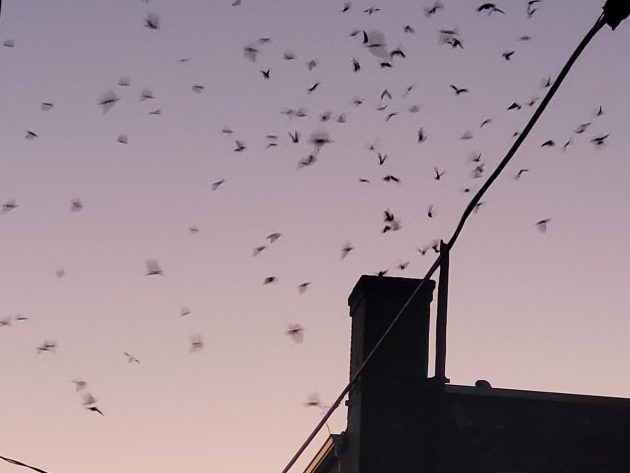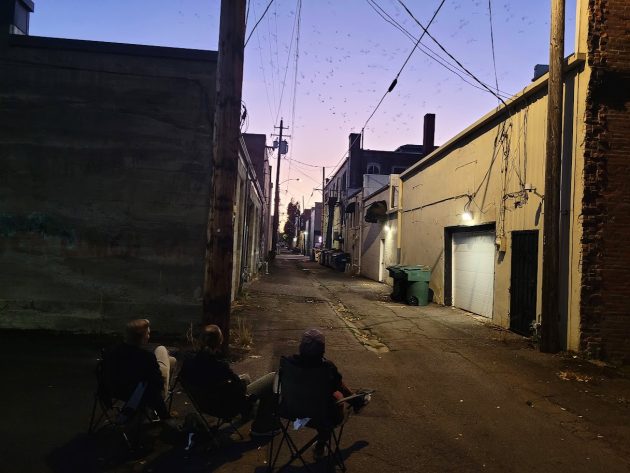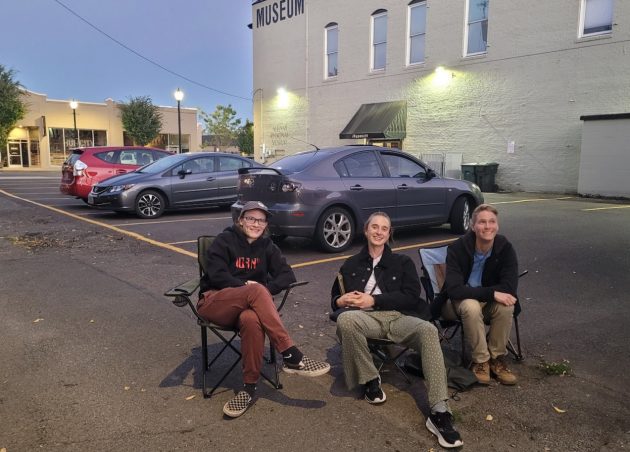
Vaux’s swifts get ready to spend the night Friday in this chimney above an Albany alley.
For years I’ve heard of flocks of little birds called Vaux’s swifts roosting overnight in Albany chimneys on their migration south for the fall. On Friday night I saw them in action for the first time.
A reader alerted me that flocks of Vaux’s swifts were spending nights in a chimney downtown. Sure enough, there they were on Friday night. They circled the chimney high in the sky for what seemed like a long time. Then they bunched up in groups and dove in as the sun went down.
This chimney is on the southeast corner of the historic Bikman Building, on an alley between Ellsworth and Lyon streets. A few feet away there’s another chimney, and I think I saw a few of the swifts go there.
You can find lots of stuff about Vaux’s swifts online. Among other things there’s proper pronunciation of Vaux’s. It is “vawks’s.”
The birds use hollow logs and similar lodgings, such as chimneys, to spend the nights on their migrations. One such chimney was at the old Fire Station 11 downtown, so when that structure was torn down for the new station, the Audubon Society of Corvallis and Albany Parks in 2016 built a 30-foot tower near Swanson Park instead.
The tower wasn’t used that or the following fall, and I haven’t checked whether it has attracted swifts since.
What I didn’t see online was information on whether the migrating flocks stay in one place for one night only before moving on. If so, sightings at the downtown chimney on two or more evenings in a row would mean you are always seeing the next flight on the migration route.
Here are more images from Friday night, followed by two videos. The first video has me wondering for nearly five minutes whether the birds were coming, followed by the payoff in video number 2. (hh)

Watching the swift show is more convenient if you bring your own chair, as these three did.

Spectators at the swift spectacle are, from left, Britt Abblitt, Olivia Johnson and Laura Fredenhagen


How is it that folks waiting for birds to fly down chimneys can be complaining about how bad the economy is and how badly those in-charge are managing said economy? Heck, even the semi-retired author has enough financial stability and personal comfort to watch and wait for Tweeties to fly-in.
What is the best time to observe
At sunset.
I got to see them probably 10-15 years ago. I was amazed so many birds went down one chimney. Thanks for reporting
We have swifts that nest in our chimney south of Brownsville every Spring. They headed south a few days ago
Very cool thank you for sharing!!
Wow! That was great – many thanks for these videos!
Very cool Hasso. Thank you.
I enjoyed watching the video.
Animals Make Us Human, by Temple Grandin
Thank you, Hasso.
Chimney swifts normally use large dead hollow trees to roost in. They started using chimneys when the trees they usually roost in are being cut down. From what I have read, they circle the roosting area to make sure it is safe from fire or predators and most of the flock is there to roost. Whole flocks of swifts have been killed when people start fires in the chimneys. Wildlife use dead trees for safe shelter, to make nests and live all year round. It would be easy to either block off dead trees from the public to keep them from getting too close or put supports on the trees to keep them from falling. Humans feel they have the right to control everything to the point of loss of life and even the right to exist. When a community values even the natural residents, everyone benefits from the respect of life. They also eat bugs like termites and flies so they earn their keep.
Thank you, Hasso! That was a treat!
The birds would go down the chimney at the GAPS administration office back in the late 90ties.
Thanks Mr Herring! Your pics & topics are always a joy to read & view. We used to live downtown & saw it a few times. Its quite a spectacle to enjoy!
I saw them last week going down a chiimney at South Shore School! So Cool!!
Yes, they depend on old chimneys, now that there aren’t enough dead, hollow, upright, old-growth trees (snags). Thousands of them roost in a chimney in an elementary school in Monroe, WA, so the chimney was retained and reinforced just for the use of swifts on their long migration. Thank you for letting us know about the Albany swifts! Hopefully we here can also retain out-of-use chimneys that the swifts are using.
Our project has documented over 26 million Vaux’s Swifts going to roost in the last 16 years. Lots of info. on our website.
http://www.vauxhappening.org